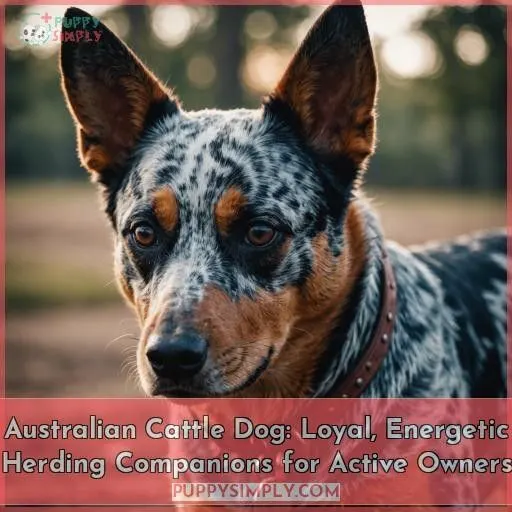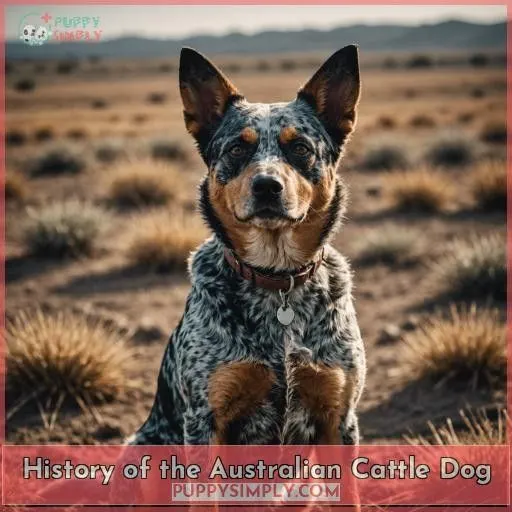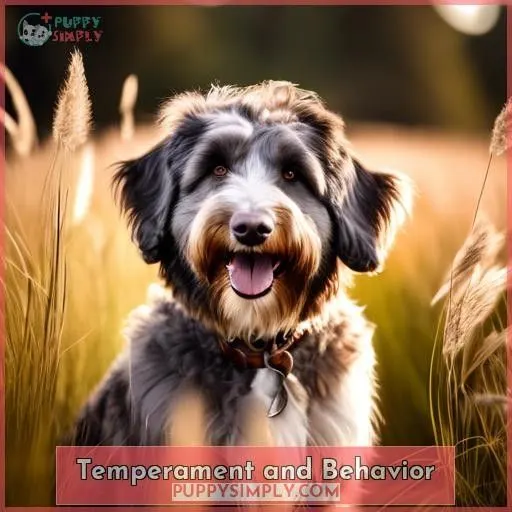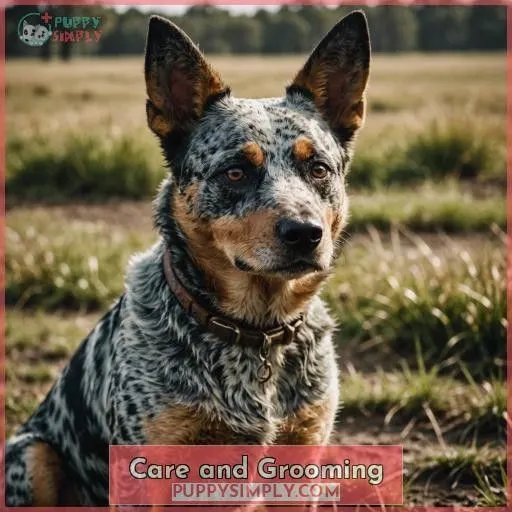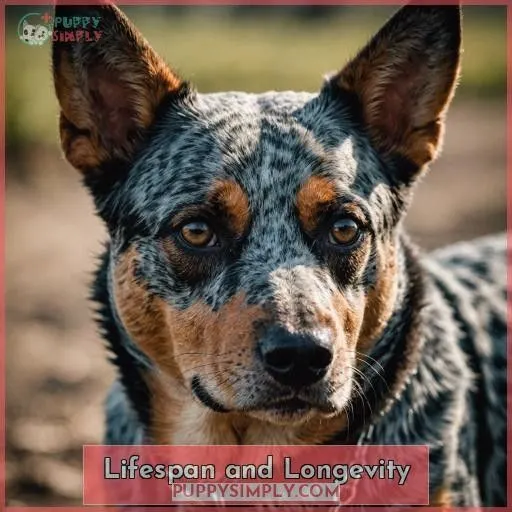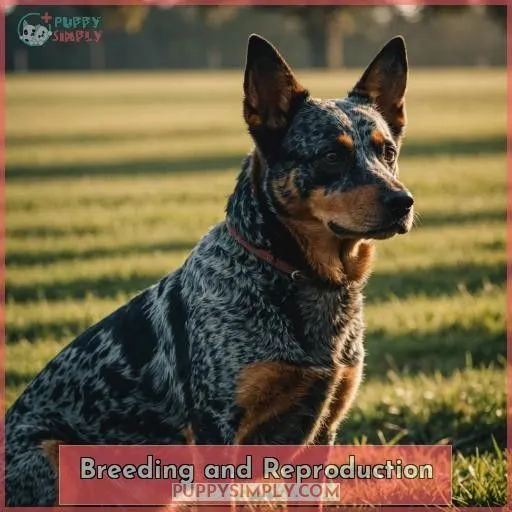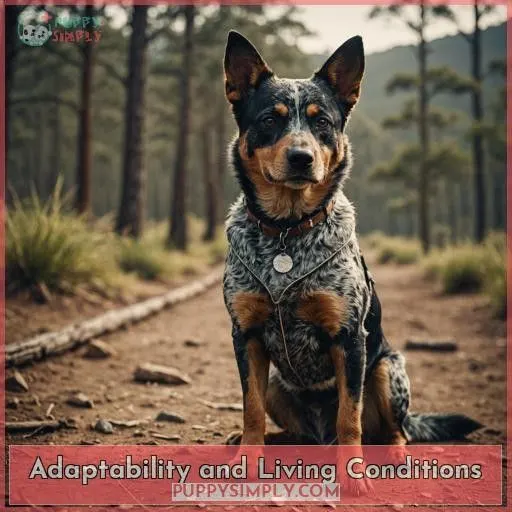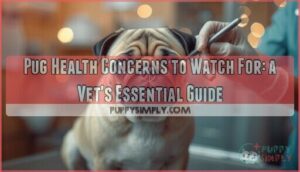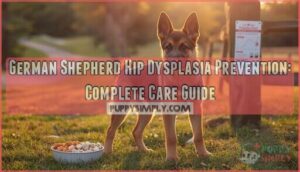This site is supported by our readers. We may earn a commission, at no cost to you, if you purchase through links.
The Australian Cattle Dog is the loyal, energetic herding companion you’ve been searching for. This intelligent breed thrives on physical and mental challenges, making them perfect for active owners.
With their distinctive blue or red speckled coat, pricked ears, and sloping croup, Australian Cattle Dogs were developed in the 19th century to excel at herding in the rugged Australian outback.
While highly trainable, they can be wary of strangers and require early socialization. These hardworking herding dogs need 1-2 hours of daily exercise to fulfill their strong instincts.
If you’re ready to meet your match in an adaptable, high-energy canine, the Australian Cattle Dog may be your ideal companion.
Table Of Contents
- Key Takeaways
- Breed Overview
- History of the Australian Cattle Dog
- Physical Characteristics
- Temperament and Behavior
- Training and Exercise Needs
- Health Concerns
- Care and Grooming
- Lifespan and Longevity
- Breeding and Reproduction
- Adaptability and Living Conditions
- Frequently Asked Questions (FAQs)
- What is the best way to introduce an Australian Cattle Dog to children?
- How can I teach my Australian Cattle Dog to be gentle with children?
- What are the signs that my Australian Cattle Dog is comfortable around my child?
- How can I socialize my Australian Cattle Dog to be more child-friendly?
- What should I do if my Australian Cattle Dog shows aggression towards my child?
- Conclusion
Key Takeaways
- The Australian Cattle Dog is a loyal, energetic breed known for its herding abilities and intelligence.
- The breed has a distinctive blue or red speckled coat and requires early socialization to get along with other dogs.
- The Australian Cattle Dog was developed in the 19th century to excel at herding in the rugged Australian outback and needs 1-2 hours of daily exercise.
- The breed is susceptible to health issues such as hip dysplasia, progressive retinal atrophy, and cardiac issues, and requires regular grooming to maintain its short, dense coat.
Breed Overview
The Australian Cattle Dog, also known as the Blue Heeler or Red Heeler, is a loyal and energetic breed that originated in Australia. Known for their herding abilities, these dogs are intelligent, independent, and highly trainable.
They come in two primary coat colors: blue and red speckle, which are achieved through the intermingling of white hairs with black or red hairs, respectively.
The breed is popular for its working ability and makes excellent companions for active owners. While their temperament can vary, they’re generally suspicious of strangers and require early and consistent socialization to get along with other dogs.
History of the Australian Cattle Dog
The Australian Cattle Dog, also known as the Blue Heeler or Red Heeler, has a rich history that’s deeply intertwined with the development of herding in Australia. The breed’s origins can be traced back to the 19th century, when Australia’s best sheep country was monopolized by the earliest British settlers, and sheep needed little direct care since they were raised on year-round permanent pastures. During this time, a number of Basque sheepherders were recruited to work in the Western Range Association, bringing their dogs with them. These dogs, which were already experienced in herding sheep for many years, became the foundation for the Australian Cattle Dog breed.
The breed’s evolution was influenced by the unique characteristics of the Australian outback and the need for a dog that could effectively herd cattle. The Australian Cattle Dog was developed to be a loyal, energetic herding companion for active owners, with a strong herding instinct and the ability to work in a variety of environments. The breed’s genetic makeup has also played a significant role in its development, with the influence of Basque herding dogs and other breeds contributing to the Australian Cattle Dog’s distinct traits.
Physical Characteristics
The Australian Cattle Dog is a muscular, herding breed with a distinctive appearance. Their coat is short and dense, with a double coat that is either blue or red speckle, with a roan coat or merle pattern. The coat is longer under the dog’s body and behind their legs, forming a mild breeching at the thighs, and is longer and thicker around the neck.
The breed has oval-shaped, medium-sized eyes, moderately-sized, pricked ears, and tails with a sloping croup that hangs in a slight curve at rest.
Males stand 18 to 20 inches tall and weigh 35 to 50 pounds, while females stand 17 to 19 inches tall and weigh 30 to 50 pounds.
Temperament and Behavior
Just like their sturdy frames suggest, Australian Cattle Dogs pack a punch in personality too. Brimming with intelligence and loyalty, they’re not just pets; they’re partners in crime (the good kind, of course). Their independence is admirable, but it means they’ve got a mind of their own—watch out for that playful streak!
While they’re protective and may eye strangers with suspicion, don’t mistake their vigilance for lack of affection. These dogs are all about balance—just like a perfectly brewed cup of coffee, strong yet comforting.
Training and Exercise Needs
Welcome to the realm of the Australian Cattle Dog! These spirited and intelligent canines are renowned for their herding instincts and boundless energy. As a dedicated owner, it’s paramount to provide your Australian Cattle Dog with ample exercise and mental stimulation to maintain its well-being and happiness.
First, let’s delve into the exercise requirements of your Australian Cattle Dog. Typically, they necessitate around 1 to 2 hours of exercise daily, which can be segmented into multiple sessions throughout the day to ensure their stimulation and contentment. This exercise should encompass both physical activity and mental challenges, as these dogs are also known for their astuteness and problem-solving abilities.
Regarding mental stimulation, training sessions centered on obedience, trickery, and scent detection can provide the necessary cognitive workout. Structured exercise, such as agility courses or organized canine sports, can effectively channel their energy and gratify their innate herding and work drives.
For individuals residing in apartments or with limited space, it’s indispensable to tailor exercise routines to accommodate your dog’s needs. Brief walks, interactive play, and mental stimulation activities can effectively maintain your Australian Cattle Dog’s activity level and engagement.
Incorporating herding instincts into your dog’s exercise routine can be an enjoyable and engaging method of providing mental stimulation. Activities such as herding balls, Frisbee, and interactive toys can facilitate your dog’s mental acuity and physical activity.
Finally, be cognizant of the manifestations of over-exercise, such as excessive panting, lameness, or a disinclination to engage in activities they typically relish. Modify exercise routines in accordance with extreme temperatures to avert discomfort or health risks.
Health Concerns
As an assistant, I’m here to help you comprehend the health matters encompassing the Australian Cattle Dog breed. These dogs are renowned for their boundless energy levels and herding instincts, but they can also be susceptible to specific health complications.
One prevalent concern is hip dysplasia, a condition where the thigh bone doesn’t align seamlessly within the hip joint. This can result in discomfort, limping, and arthritis in the affected joint. The Orthopedic Foundation of America has ascertained that 16% of Australian Cattle Dogs possess hip dysplasia, which is a substantial percentage for a medium-sized dog breed.
Another health issue is progressive retinal atrophy (PRA), an inherited form of degenerative ocular disease that can cause blindness in Australian Cattle Dogs. Fortunately, a straightforward DNA test is accessible to ascertain if a dog has the disease, carries the disease, or is entirely free of it.
Ocular ailments aren’t the sole health concerns for this breed. They can also be vulnerable to cardiac issues, seizures, liver shunt, and hereditary deafness.
In terms of grooming, Australian Cattle Dogs possess short, dense undercoats and water-repellent straight outercoats. They shed a moderate to substantial amount and will benefit from daily brushing. Twice per annum, they’ll shed their dense undercoats and can benefit from a professional groomer or bather.
To maintain your Australian Cattle Dog’s well-being, it’s imperative to provide a balanced diet, regular exercise, and routine veterinary care. Maintaining a healthy weight can assist in preventing joint issues and other health problems.
Care and Grooming
Caring for an Australian Cattle Dog is effortless, thanks to their low-maintenance coats and versatile nature. Here’s a step-by-step guide to keeping your ACD looking and feeling their best:
- Brushing: Brush your ACD’s coat weekly to remove dead hair and maintain its shine. Use a bristle or slicker brush for the short, dense undercoat. During shedding seasons, you may need to brush more frequently to prevent tangles.
- Bathing: Bathe your ACD only when necessary, as their water-repellent double coat requires minimal grooming. If they become extremely dirty, give them a bath using a mild dog shampoo.
- Nail Trimming: Trim your ACD’s nails as needed, depending on their activity level. Puppies may require weekly trimming, while adults can go approximately once a month.
- Dental Hygiene: Brush your ACD’s teeth regularly to promote good dental hygiene and freshen their breath. This can help prevent gum disease and other dental problems.
- Ear Care: Check your ACD’s ears regularly for cleanliness and signs of infection. Clean their ears with a gentle ear cleaner as needed.
- Feeding: Feed your ACD a premium dog food twice daily. Puppies should be given puppy food until they reach approximately 12 months of age, then switch to adult food.
- Treats and Accessories: Reward your ACD with healthy treats for training and good behavior. Consider utilizing accessories such as harnesses, leashes, and collars to enhance their comfort and protection.
Lifespan and Longevity
Australian Cattle Dogs are renowned for their robust health and vitality, often living well into their mid to late teens. On average, they’ve a lifespan of 12 to 15 years, with some individuals reaching 17 or 18 years. This longevity is a testament to the breed’s resilience and adaptability, which have been refined over generations in the challenging terrains of Australia.
Here are four key points about the lifespan and longevity of Australian Cattle Dogs:
- Average Lifespan: The average lifespan of an Australian Cattle Dog is between 12 and 15 years.
- Potential Lifespan: Some Australian Cattle Dogs have been known to live up to 17 or 18 years, making them one of the longer-lived breeds.
- Factors Affecting Lifespan: Genetics, diet, exercise, and health care can all influence the lifespan of an Australian Cattle Dog.
- Comparative Lifespan: Australian Cattle Dogs are among the breeds with a longer lifespan, compared to medium-sized dog breeds, which typically have a lifespan of 10 to 13 years, and large dog breeds, which have an average lifespan of 8 to 12 years.
These loyal, energetic herding companions aren’t only cherished for their long lives but also for their unwavering loyalty, intelligence, and drive, which make them ideal pets for active owners.
Breeding and Reproduction
Reproduction and breeding are critical aspects of the Australian Cattle Dog’s existence. These dogs are renowned for their unwavering herding instincts and sharp minds, rendering them exceptional working companions. Breeding frequency tends to be lower than that of other breeds, with an average of one litter per annum. Genetic testing is vital to guarantee the well-being of the offspring, with stud services accessible to aid in preserving the breed’s standards and traits.
Puppy care is paramount, and it’s advisable to initiate socialization at an early stage to ensure that Australian Cattle Dogs develop into well-adjusted, amicable companions. The breed holds a place in the Guinness Book of World Records for its remarkable longevity, with some individuals reaching an age of 29 years and 5 months.
For those contemplating breeding Australian Cattle Dogs, it’s imperative to conduct thorough research and gain a comprehensive understanding of the breed’s characteristics, health considerations, and training requirements. Breeding should be undertaken responsibly, with the utmost priority being given to the welfare of the dogs and their progeny.
Adaptability and Living Conditions
When evaluating an Australian Cattle Dog as a companion, it’s essential to comprehend their flexibility to various living environments. Here are three significant aspects to ponder:
- Apartment Living: Despite their energy levels, many Australian Cattle Dogs can acclimate well to apartment living with appropriate exercise and training.
- Cold Weather Tolerance: Red and blue heelers are innately endowed to withstand cold weather, owing to their thick coats and robust builds.
- Heat Weather Tolerance: These dogs possess short coats and lean body structures that promote heat dissipation, rendering them suitable for warmer climates.
Frequently Asked Questions (FAQs)
What is the best way to introduce an Australian Cattle Dog to children?
Start slow, let the kids approach the dog calmly. Reward good behavior and supervise closely. With patience and consistency, the ACD can become a loyal, protective companion for the whole family.
How can I teach my Australian Cattle Dog to be gentle with children?
Imagine your cattle dog as a curious pup exploring their world – with your gentle guidance, they’ll learn to tread lightly around little ones, respecting their space. Positive reinforcement’s key – reward calm, gentle behavior, and they’ll become your family’s faithful companion.
What are the signs that my Australian Cattle Dog is comfortable around my child?
You’ll know your cattle dog is at ease when they wag their tail, lean in for pets, and play gently with your child. They’ll also relax their body language and allow your child to approach them calmly.
How can I socialize my Australian Cattle Dog to be more child-friendly?
Socialize your pup like a social butterfly – introduce them to kids in a controlled, positive environment. Heap on the praise when they calmly interact, and you’ll have a child’s best friend in no time!
What should I do if my Australian Cattle Dog shows aggression towards my child?
If your child is facing aggression from your dog, don’t panic – nip this in the bud through expert guidance and consistent training. With the right approach, you can turn that pup into your child’s best friend.
Conclusion
An apple a day keeps the doctor away. The same can be said for the Australian Cattle Dog.
If you’re an active owner ready to meet your match in a high-energy, adaptable canine, the Australian Cattle Dog may be your ideal four-legged companion. These speckled pups have loyal, herding instincts and a need for daily exercise, which will keep you on your toes.
The rewards of owning an Australian Cattle Dog are undeniably worth it.

